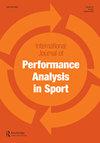How hormones, vertical jump and perceived exertion change in clutch time. A season case study of an amateur basketball team
IF 1.6
4区 教育学
Q2 SPORT SCIENCES
International Journal of Performance Analysis in Sport
Pub Date : 2023-11-06
DOI:10.1080/24748668.2023.2277627
引用次数: 0
Abstract
ABSTRACTBasketball clutch time is defined as minutes when the scoring margin is within 5 points with five or fewer minutes remaining in a game. Our aims were to explore the relations and to compare testosterone and cortisol behaviours, vertical jump (CMJ) and perceived exertion (RPE) between clutch time games (CT) and non-clutch time games (N-CT); during a season in an amateur male team (24.02 ± 3.36 years). Data was collected at 22 games considering CT (n = 8) or N-CT (n = 14) depending on the scoring margin with five or fewer minutes. A total of 120 player cases who participated in the last 5 min of each game (CT, n = 48; N-CT, n = 72) were analysed using a mixed linear model for repeated measures to compare the CT and N-CT variations. The main results were Cortisol, CMJ and RPE means turned out to be higher in CT, but relevant differences were only identified for RPE (ES = 0.69). Findings suggested that clutch performance was often viewed through players’ subjective parameters. Consequently, we recommend that both players and coaches consider it for CT performance. In addition, we extend current basketball CT indicator knowledge opening future research and applied practice.KEYWORDS: Team sporttestosteronecortisolcountermovement jumpRPE AcknowledgementsThe authors would like to thank the athletes and coaches for participating in the studyDisclosure statementNo potential conflict of interest was reported by the author(s).激素,垂直跳跃和感知用力在离合器时间是如何变化的。某业余篮球队赛季案例分析
【摘要】篮球比赛的关键时刻是指在比赛剩余时间少于5分钟的情况下,得分差距在5分以内的时刻。我们的目的是探讨在关键时刻游戏(CT)和非关键时刻游戏(N-CT)之间的关系,并比较睾酮和皮质醇行为、垂直跳跃(CMJ)和感知消耗(RPE);业余男队一个赛季(24.02±3.36年)。根据5分钟或更少的得分差,在22场比赛中考虑CT (n = 8)或n -CT (n = 14)收集数据。每场比赛最后5分钟参与比赛的120例(CT, n = 48;n -CT, n = 72)使用混合线性模型进行重复测量,比较CT和n -CT的变化。主要结果是皮质醇、CMJ和RPE均值在CT中升高,但相关差异仅在RPE中发现(ES = 0.69)。研究结果表明,离合器性能通常是通过球员的主观参数来看待的。因此,我们建议球员和教练考虑CT表现。此外,我们拓展了现有的篮球CT指标知识,为未来的研究和应用实践打开了大门。关键词:团队运动,睾丸激素,激素,反动作跳跃,感谢作者感谢参与研究的运动员和教练员披露声明作者未报告潜在的利益冲突。
本文章由计算机程序翻译,如有差异,请以英文原文为准。
求助全文
约1分钟内获得全文
求助全文
来源期刊

International Journal of Performance Analysis in Sport
Health Professions-Physical Therapy, Sports Therapy and Rehabilitation
CiteScore
4.40
自引率
4.80%
发文量
38
期刊介绍:
The International Journal of Performance Analysis in Sport aims to present current original research into sports performance. In so doing, the journal contributes to our general knowledge of sports performance making findings available to a wide audience of academics and practitioners.
 求助内容:
求助内容: 应助结果提醒方式:
应助结果提醒方式:


